I'll admit that there have been times when certain subject matter of music theory has caused me to roll my eyes and tune out. In fact, I don't care for the term "music theory" even though I sometimes grudgingly use it.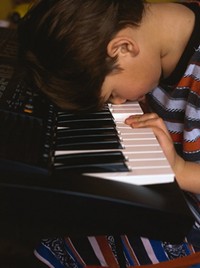
I also have learned that formal music instruction has over complicated some concepts that could have been very simple to understand from the beginning. I want to share with you one of these concepts that really turns off beginning piano students because I believe it's not simplified.
I'm talking about enharmonic keys of music. An enharmonic key of music is equivalent to some other key of music but spelled or named differently. There's a very logical explanation as to why this exists. I'm going to be using a tool called the circle of 5ths to explain this concept.
If you're familiar with the circle of 5ths, you know that it's a geometrical representation of several musical elements including keys of music. That's what we'll focus on here.
If we're looking at the circle of 5ths in terms of Major keys of music, it begins at the top and center with the key of C Major in which there are no sharps or flats in the key. 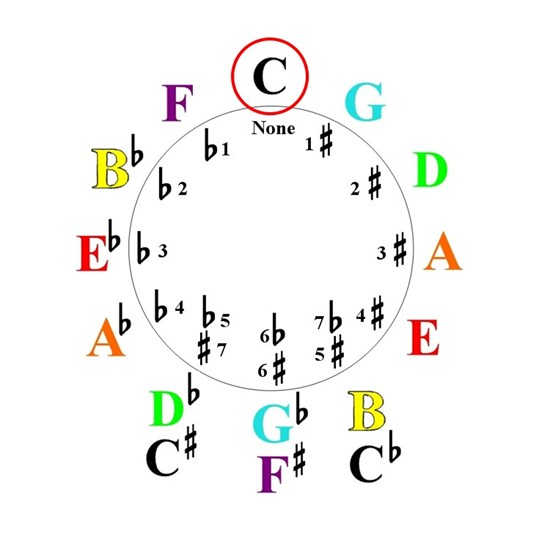 Proceeding clockwise around the circle, each subsequent key accumulates one sharp.
Proceeding clockwise around the circle, each subsequent key accumulates one sharp.
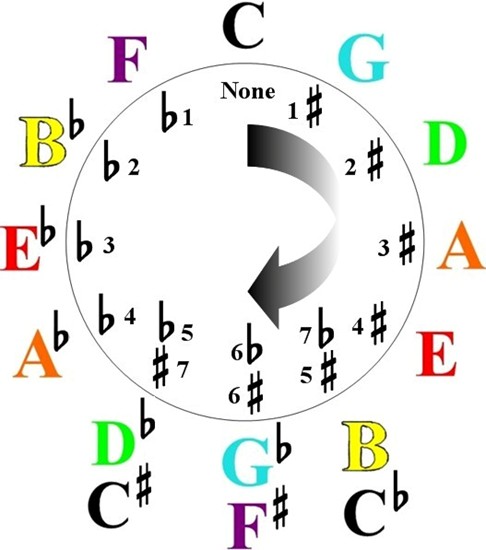
At the same time, proceeding counter-clockwise around the circle each subsequent key accumulates one flat.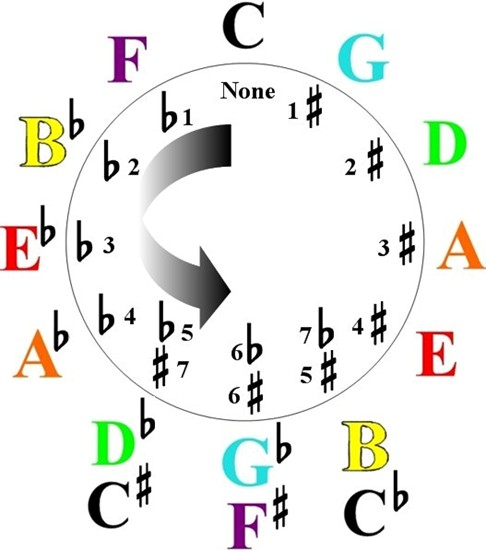 These Major keys with sharps and flats reach an ending point around the circle but not until they overlap one another.
These Major keys with sharps and flats reach an ending point around the circle but not until they overlap one another.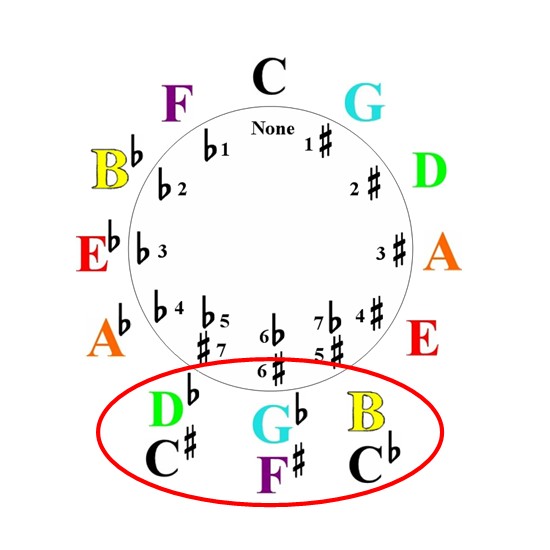 This overlapping of Major keys creates this enharmonic spelling. As you can see, there are six enharmonic keys and it helps to understand the spelling of the notes in all of them.
This overlapping of Major keys creates this enharmonic spelling. As you can see, there are six enharmonic keys and it helps to understand the spelling of the notes in all of them.
Let's take a look at the simple structure of a Major key of music and its diatonic spelling.
A Major key of music consist of the following Whole step/half step pattern. Every Major key of music must contain the first 7 letters of the alphabet. No one letter is referred to more than once and no letter is skipped. The reason for these guidelines is to maintain a consistency among all Major keys and avoid confusion. This isn't to say that you must always adhere to strict rules of music theory. I will say that it's ok to break the rules only after you know what they are.
Every Major key of music must contain the first 7 letters of the alphabet. No one letter is referred to more than once and no letter is skipped. The reason for these guidelines is to maintain a consistency among all Major keys and avoid confusion. This isn't to say that you must always adhere to strict rules of music theory. I will say that it's ok to break the rules only after you know what they are.
The first enharmonic keys we'll take a look at are B and C flat Major. They both have 5 black keys and 2 white keys.
Without naming the notes, you can see that they're identical. The key of B Major contains 5 sharps. It's easy to discern, because all of the accidentals (sharps in this key) are on black keys. The key of C flat Major contains 7 flats. But it's not as clear as B Major, because some of the accidentals are on white keys so let's take a look only at the accidentals on white keys in C flat Major.
The key of B Major contains 5 sharps. It's easy to discern, because all of the accidentals (sharps in this key) are on black keys. The key of C flat Major contains 7 flats. But it's not as clear as B Major, because some of the accidentals are on white keys so let's take a look only at the accidentals on white keys in C flat Major.
What we recognize as B is referred to as C flat. So our first accidental is on a white key.
The fourth tone in the key of C flat appears to be E but it's actually F flat.
Moving on, we'll look at G flat and F sharp Major. They both have 5 black keys and 2 white keys.
They too, like the last pair of enharmonic keys we looked at are identical. The key of F sharp Major contains 6 sharps. Only 1 white key isn't referred to as its natural note name. What we recognize as F is referred to as E sharp. It's the only accidental on a white key. The B of course is natural.
The key of F sharp Major contains 6 sharps. Only 1 white key isn't referred to as its natural note name. What we recognize as F is referred to as E sharp. It's the only accidental on a white key. The B of course is natural. The key of G flat has 6 flats. Only 1 white key isn't referred to as its natural note name. What we recognize as B is referred to as C flat. It's the only accidental on a white key. The F of course is natural.
The key of G flat has 6 flats. Only 1 white key isn't referred to as its natural note name. What we recognize as B is referred to as C flat. It's the only accidental on a white key. The F of course is natural.
If you'll notice, we didn't have any of these enharmonic keys in which there was a lettered note skipped or repeated. Of course, this is why you have some accidentals that are on white keys. However, musicians including myself will often if not always, refer to these accidentals as their natural note names.
As I stated before, it's ok to break the rules only after you know what they are. This applies here in respect to referring to, or thinking of these notes. It's not necessarily about how you may refer to them to someone else, but how you might simply think of them to make it easier for you to play in those keys. Trust me, no one will judge your performance based on how you referred to a note in your own head.
If you're familiar with diatonic harmony (diatonic just means in the key), you're aware that each one of these tones have a corresponding chord. Because these enharmonic keys exist, these chords can be tricky because they too can be referred to with different spelling and names. So I want to share with you an easier way for a piano player to deal with the harmony that accompanies enharmonic keys.
Let's take a look at the diatonic harmony of B Major.
B Major diatonic harmony:
The 1 chord is B Major. This chord is simple to discern because it exists as one of the 12 Major chords. The 2 chord is C sharp minor. It's one of the 12 minor chords and is also a simple chord to discern.
The 2 chord is C sharp minor. It's one of the 12 minor chords and is also a simple chord to discern. The 3 chord is D sharp minor. This is where many piano students will have friction with enharmonic diatonic harmony. The reason for this is that D sharp minor doesn't exist as one of the 12 minor chords. It's not a common chord to think of and there is a better option.
The 3 chord is D sharp minor. This is where many piano students will have friction with enharmonic diatonic harmony. The reason for this is that D sharp minor doesn't exist as one of the 12 minor chords. It's not a common chord to think of and there is a better option. Another way to think of the 3 chord in B Major is as an E flat minor chord. E flat minor is one of the 12 minor chords and is also a very common chord in other keys. Even though there are no flats in B Major, you can still think of E flat as the 3 chord because it's easier.
Another way to think of the 3 chord in B Major is as an E flat minor chord. E flat minor is one of the 12 minor chords and is also a very common chord in other keys. Even though there are no flats in B Major, you can still think of E flat as the 3 chord because it's easier. The 4 chord is a simple E Major.
The 4 chord is a simple E Major. The 5 Chord is a simple F sharp Major. However, if you view this chord as a G flat Major it will be just as simple to discern.
The 5 Chord is a simple F sharp Major. However, if you view this chord as a G flat Major it will be just as simple to discern. The 6 chord is G sharp Minor. This chord is also an uncommon chord that is difficult to discern for piano players. It's easier to think of it as an A flat minor chord instead.
The 6 chord is G sharp Minor. This chord is also an uncommon chord that is difficult to discern for piano players. It's easier to think of it as an A flat minor chord instead. The 7 chord is A sharp diminished. This is another uncommon and difficult chord to discern. A B flat diminished triad is an easier way to think of this chord.
The 7 chord is A sharp diminished. This is another uncommon and difficult chord to discern. A B flat diminished triad is an easier way to think of this chord.
We've covered the diatonic harmony in B Major and some alternatives to the formal chord definitions. I also want to point out that as a piano player, it's often easier to discern chords in the context of flats instead of sharps. Why is this? Let's take a look at the circle of fifths again.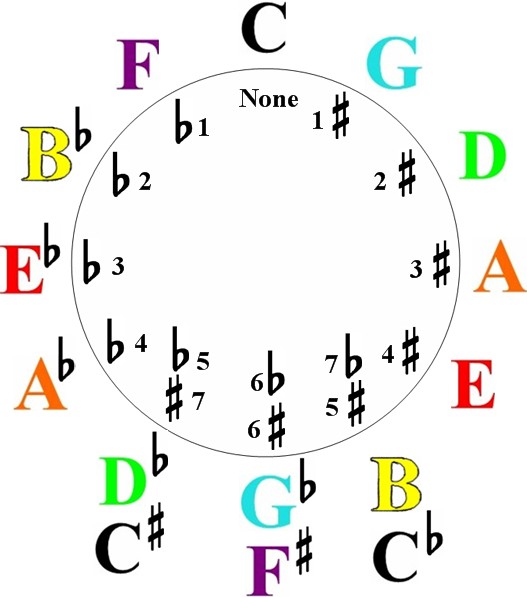
There are 6 keys with flatted notes as the tonic (first note in the key). There are only 2 keys with sharped notes as the tonic. Simply put, flats are more common in the context of chords and are more natural to piano players. It's not this way with all instrumentalists. For example, guitar players often prefer keys that have open strings such as E, A, D, Etc. And for this reason, a lot of popular songs are written in those keys.
The purpose of this article is to be aware of what the "rules" are when you're faced with either following instruction, or communicating with another musician. Beyond this, break the rules to make it easier for you to discern and play harmony without getting stumped no matter what key of music you're playing in.
Until next time, Go Play!
Greg Lee
Latest posts by Greg Lee (see all)
- What is a minor/Major 7 Chord? - October 26, 2023
- 7 Chord Substitutions that Professionals Use - October 19, 2023
- 5 Simple Chord Tricks to Sound Amazing - October 5, 2023



